In marketing, understanding who you do not want to target is as crucial as knowing your desired audience. The process of removing names and addresses from mailing lists before distribution can be labor-intensive and involve extensive spreadsheet management. This is why we are thrilled to introduce our new direct mail suppression lists with the latest release of Postalytics.
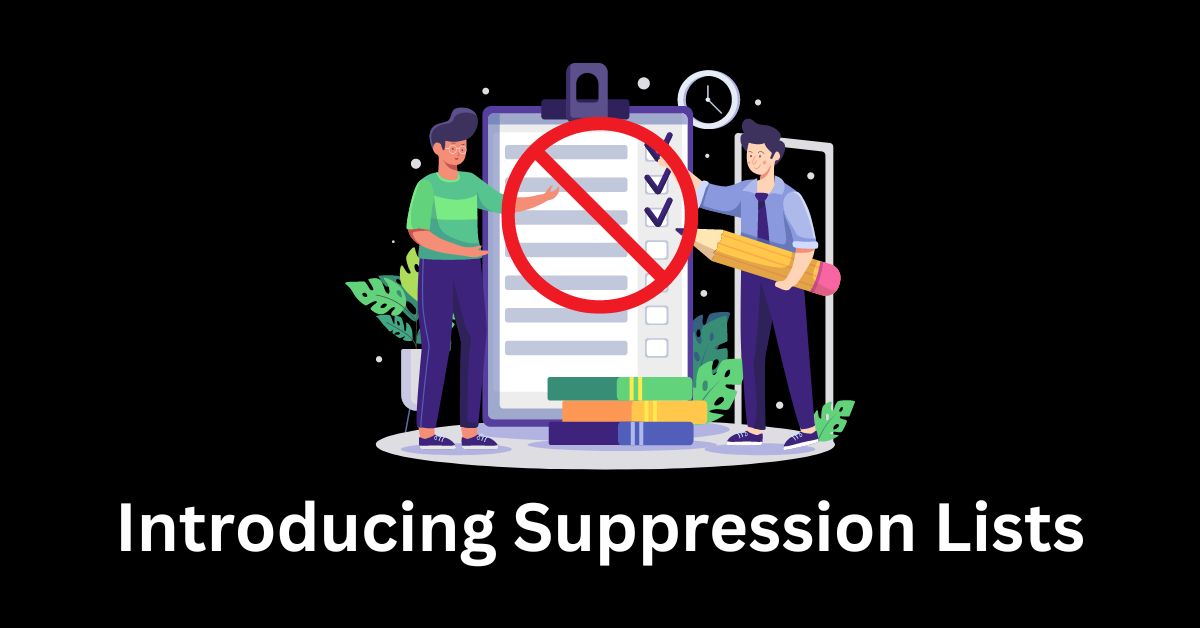
In addition to the suppression list feature, there’s a TON of new great enhancements in this release. Read on for more information.
Table of contents
- Postalytics Has Always Supported Invalid Address Suppression
- Direct Mail Suppression Lists Reduce Costs and Save Time
- How Postalytics Suppression Lists Work
- HighLevel Integration Updates
- Salesforce Integration Updates
- Agency Edition Updates
- System Performance Updates
- USPS and Canada Post Postage Increases
- What’s Next?
Postalytics Has Always Supported Invalid Address Suppression
From the beginning, Postalytics has incorporated various forms of address suppression as standard features. These suppressions are integrated into the contact import and campaign sending functionalities of Postalytics. These traditional features are designed to automatically exclude:
- Duplicate addresses
- Improperly formed addresses missing essential mailing information
- Addresses marked as ‘Return to Sender’ or ‘Mail Forwarded’ from the USPS IMB system
With this release, we are enhancing our list management tools to include the upload and management of direct mail suppression lists. These lists assist marketers in excluding recipients with valid addresses from mailings for strategic marketing and customer experience purposes.
Direct Mail Suppression Lists Reduce Costs and Save Time
Sending mail to recipients who are not the target for a specific campaign is inefficient, as it wastes valuable budget and can inadvertently lead to a negative experience for those recipients. The classic use case for direct mail suppression lists involves prospecting/lead generation campaigns involving existing customers. You really don’t want to send a mailer highlighting a product to a recipient that has recently bought that product!
Consequently, marketers have traditionally used suppression lists to prevent certain recipients from receiving direct mail offers. How is this accomplished? Usually, it involves extensive work with spreadsheets.
A suppression list is often created by exporting data from a CRM or accounting system, followed by a manual comparison of this list against the list of potential recipients. This laborious task can take hours and significantly drain both time and financial resources.
Postalytics suppression lists automate the arduous task of address comparison across different lists, eliminating the need for your staff or your printer’s staff (both of whom you’re paying for) to manage it.
How Postalytics Suppression Lists Work
To setup a Suppression List in Postalytics, you follow the exact steps that you’d follow to import a new contact list. You can import a suppression list using a .CSV or Excel file, or if you maintain a list in your CRM or Marketing Automation tool, use a Postalytics integration to import your list.
The only additional step involves selecting the “List Type” during the list import process, you can now distinguish between Contact Lists and Suppression Lists.
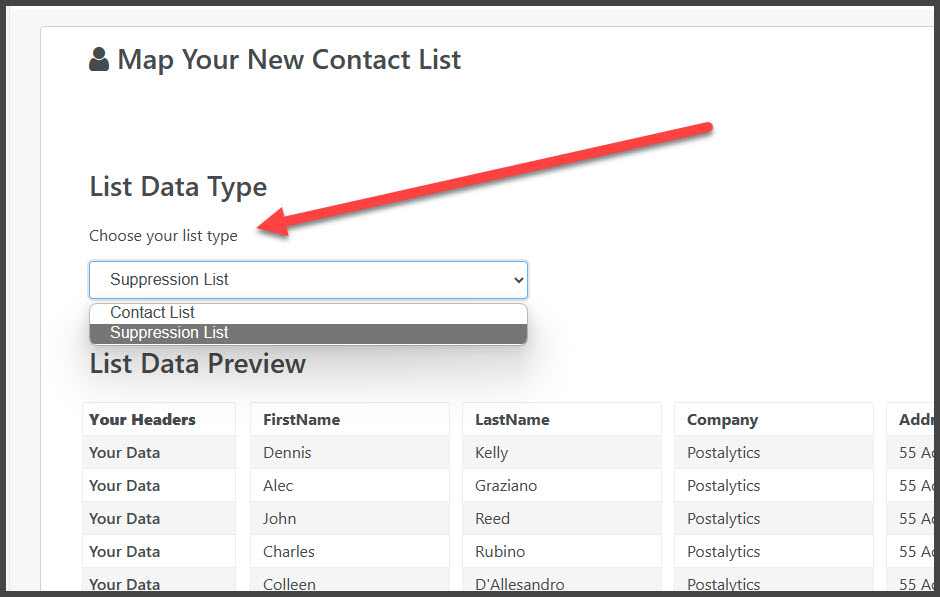
Postalytics Uses the CASS System to Standardize Addresses for Comparison
For software to perform the list suppression tasks typically done by humans, addresses must be standardized. Otherwise, the software wouldn’t match “123 Main St, Anytown USA 01234″ with “123 Main Street, Anytown USA 01234.”
Fortunately, Postalytics uses an address standardization system known as CASS (Coding Accuracy Support System) for our mailing process, and we’ve been able to adapt it for use with the Suppression List feature.
As a result, addresses on your suppression list will be reformatted by Postalytics to match the standardized format used for mailing, enabling the software to identify matches and suppress the corresponding address from the mailing list.
Choose a Direct Mail Suppression List Using the Campaign Wizard
Once you’ve uploaded your suppression list, you simply choose to add it to your campaign in the “Recipients” step of the Campaign Wizard. Of course, you do not have to choose a suppression list, it is entirely up to you. Note, currently you can only choose one suppression list per campaign.
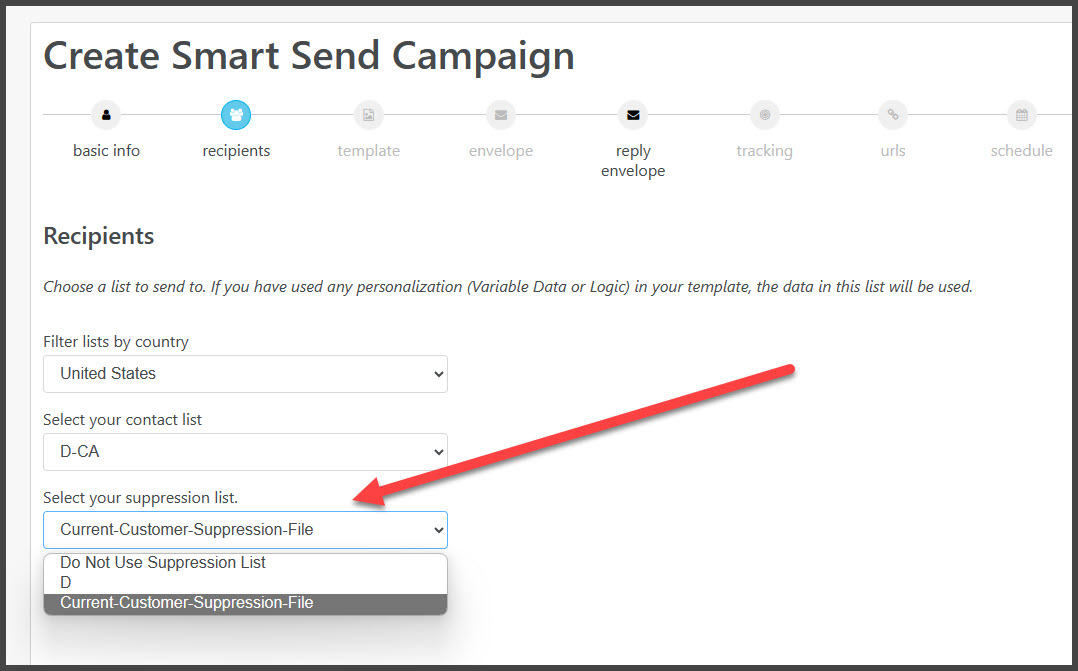
Once you select your suppression list in the campaign wizard, your job is complete! Postalytics will handle everything else, ensuring that your suppressed recipients are excluded from the mailing. This process saves you hours of time and money with just a few clicks!
Manage Your Suppression Lists Via In-app Tools or API
Suppression lists require regular updates and maintenance as the status of different audience segments changes. For instance, a “Current Customer” suppression list should be updated to include new customers and remove former ones. This task is straightforward; you can access and update the list using the same tools employed for managing your Contact Lists.
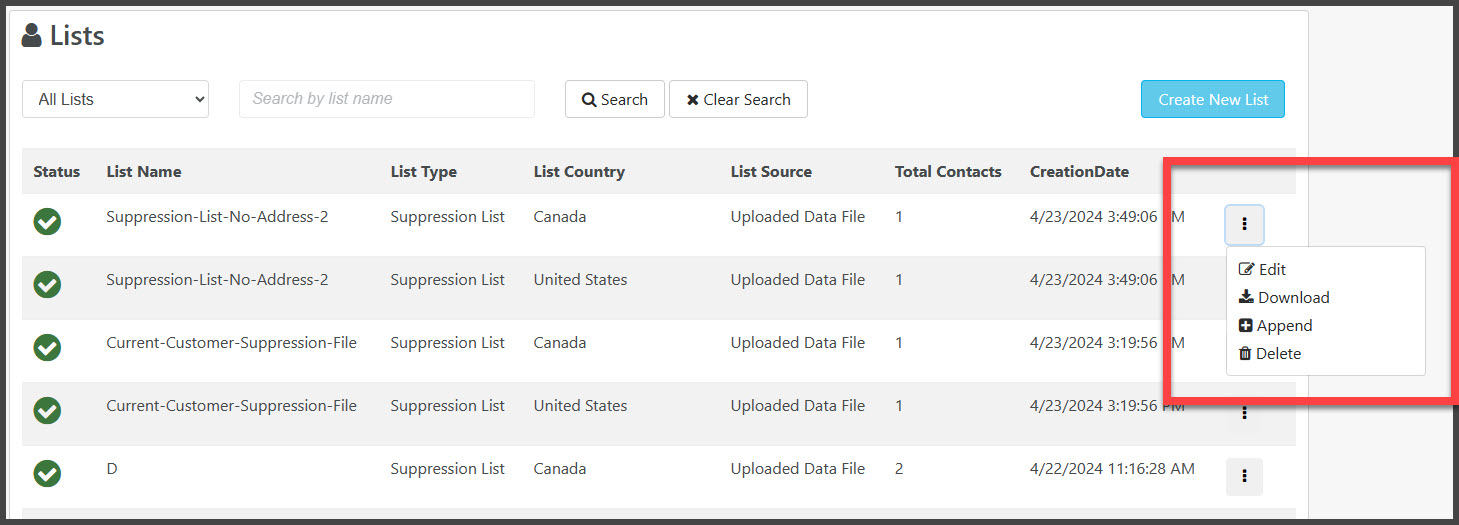
In addition to the controls available in the application, you can update your Suppression Lists via the Postalytics API. You’re able to Get, Create and Delete Suppression Lists. And for Suppression List Contacts, you’re able to Get, Create, Update and Delete.
Direct Mail Suppression Lists are Available in All Postalytics Plans…For Now
For the introduction of the Suppression List feature, we’re making it available in all Postalytics plans. While this may be upgraded to a premium feature in the future, today all Postalytics users can access this new tool to enhance your campaigns.
For more details on how it all works, check out the new Knowledgebase articles on Direct Mail Suppression Lists.
HighLevel Integration Updates
HighLevel (or GoHighLevel) is a fast-growing CRM/Marketing Automation platform that many Postalytics customers use in either their branded or white-labeled version (known as Lead Connector HQ). The HighLevel team has been adding new capabilities at a fast and furious pace, and as a result we’ve launched an entirely new set of HighLevel integration options.
New HighLevel APIs – Required Update by 6/1/2024
The API’s that HighLevel partners like Postalytics have been using to build our integrations have been updated and modernized. This has enabled us to build a faster, better and more complete HighLevel integration. If you’re a current HighLevel integration customer, you’ll need to update your integration in the Postalytics Connect menu under your username.

The current HighLevel APIs that the previous version of the Postalytics integration used are being deprecated or removed as of 6/1/2024, so be sure to upgrade to the latest version soon!
Postal Connector: New White-labeled Version of the HighLevel Integration
Many customers that are using the Postalytics HighLevel integration are using white-labeled versions. The Postalytics Agency Edition supports white-labeling, and HighLevel has a version they call “Lead Connector HQ” that removes all HighLevel branding from their application.
That being said, previous versions of the HighLevel APIs did not allow a fully white-labeled integration to be developed by partners like Postalytics. Now, with the new APIs, we’re proud to launch the availability of the “Postal Connector”, a fully white-labeled version of our integration.
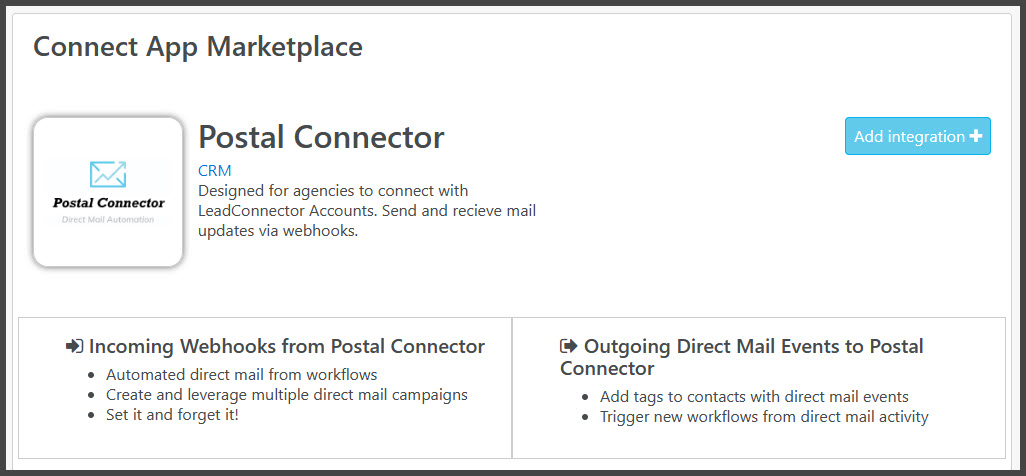
When you choose to install the Postal Connector version of the Postalytics HighLevel Integration, you’ll be directed a fully white-labeled page on the HighLevel side, and all facets of Postalytics branding are removed from the integration.
Get more details from the new set of Knowledgebase articles for the Postal Connector integration.
Salesforce Integration Updates
Our Salesforce Integration has significantly aided customers in automating their direct mail through both Smart Send and Triggered Drip campaigns. As we expand, we have focused our investments on improving and updating the technology that powers this integration. The latest release unveils a robust suite of technologies that will allow the Salesforce integration to support an increased number of customers and a higher volume of direct mail, all within a highly efficient and secure framework.
Current customers do not need to take any action to benefit from this upgrade; simply continue to utilize this dynamic integration to automate your mailings.
Agency Edition Updates
There are two important upgrades to the Postalytics Agency Edition that will enable smoother and easier client account setup and communication flows between the agency parent account and client sub-accounts.
Client Account Email Address – No Longer Needs to be Unique
Customers using the Agency Edition can now set up new client accounts without requiring a unique email address for each one. This update streamlines the account creation process and complements the notification change mentioned below, guaranteeing that essential alerts are sent to addresses where your team will receive and act upon them promptly.
Agency Notifications Configuration
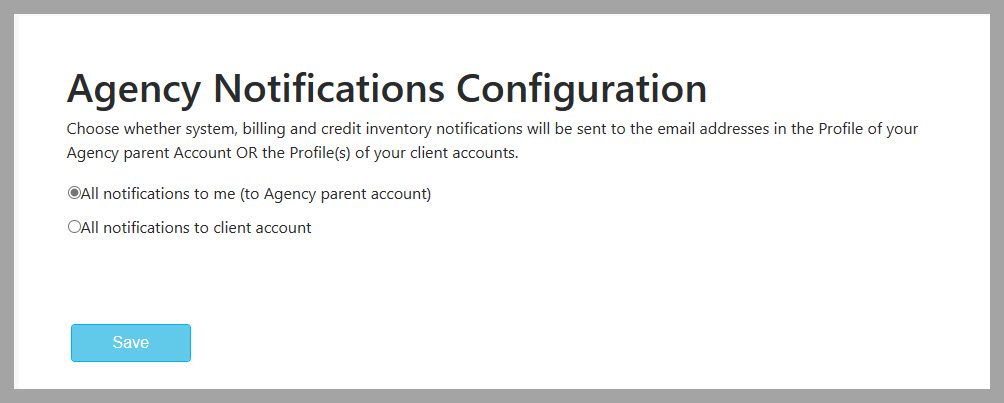
This update allows the Agency parent account to configure a system-wide setting that sends system, billing, and credit inventory email notifications to the email addresses listed in the Agency parent account’s Profile or to those in the Client Accounts’ Profiles. This feature provides Agency Edition users, who actively manage Client Accounts, with an improved method to monitor Client Account activities.
System Performance Updates
The substantial growth of Postalytics, reflected in the increased number of customers and total campaigns, has led to the identification of several performance bottlenecks within the application. This release introduces major system performance improvements that will enable users to navigate the system with greater efficiency. Significant performance enhancements have been made in several areas of the application, including:
- Campaign listings
- Campaign dashboards
- Contact List listings
- Template listings
USPS and Canada Post Postage Increases
Finally, we’ve recently learned that the USPS has filed with the Postal Regulatory Commission (PRC) for another increase in postage rates. If approved, this rate increase will take place on July 14th. Stay tuned for more information on the impact to Postalytics rates in the coming months. Also, Canada Post has increased their postage rates, and we’ll be updating our Canada pricing accordingly. More details for Canada mailers coming soon.
What’s Next?
We have a pipeline of several new features that will be released over the coming weeks, including:
- A new method of capturing direct mail campaign responses
- Enhancements to our custom envelope and letter products
- Automated File Campaign enhancements
- New integrations
- New 3rd party data options
- New campaign types
- Sales tax calculation
- And much more
Stay tuned for these upcoming announcements and thank you for choosing Postalytics! If you’d like to speak with us about any of these announcements, please reach out to us.
About the Author

Dennis Kelly
Dennis Kelly is CEO and co-founder of Postalytics, the leading direct mail automation platform for marketers to build, deploy and manage direct mail marketing campaigns. Postalytics is Dennis’ 6th startup. He has been involved in starting and growing early-stage technology ventures for over 30 years and has held senior management roles at a diverse set of large technology firms including Computer Associates, Palm Inc. and Achieve Healthcare Information Systems.
